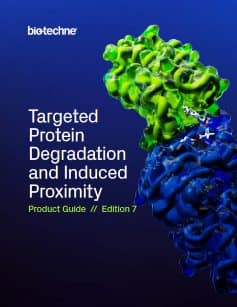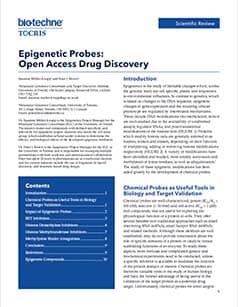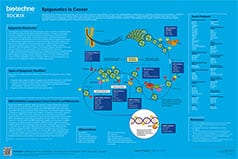Protein Degraders
Protein Degraders (e.g.PROTAC® molecules, SNIPERs etc), are a new approach for the knockdown of target proteins within cells. Comprising binding moieties for an E3 ubiquitin ligase and a target protein joined by a linker, these hybrid molecules induce selective, proteasome-dependent degradation of target proteins and can be used to investigate downstream effects of protein knockdown or to interfere with specific signaling pathways.
PROTAC® is a registered trademark of Arvinas Operations, Inc., and is used under license.
Protein Degraders (e.g.PROTAC® molecules, SNIPERs etc), are a useful approach for the knockdown of target proteins within cells. Comprising binding moieties for an E3 ubiquitin ligase and a target protein joined by a linker, these hybrid molecules induce selective, proteasome-dependent degradation of target proteins and can be used to investigate downstream effects of protein knockdown or to interfere with specific signaling pathways. The methodology provides an attractive alternative to RNAi methods and has several advantages including:
- Ease of use: protein Degraders are cell permeable small molecules that can be applied directly to cells with no need for expression vectors or transfection
- The duration of effect is adjustable and can be reversed on compound washout
- Broad applicability to different cell lines, small molecule Degraders do not require cells that are easily transfectable
- Catalytic mode of action: they dissociate following ubiquitination and rebind to new target proteins, which allows their use at sub-stoichiometric concentrations.
Protein Degraders - Tools for Targeted Protein Degradation

Figure 1: Schematic showing the catalytic mode of action of heterobifunctional degrader molecules. Degraders initiate the formation of a ternary complex between an E3 ubiquitin ligase and a target protein which results in polyubiquitination of the target protein, its recognition by the proteasome and subsequent degradation. Degraders act catalytically by repeatedly engaging and directing the ubiquitination of target molecules.
Adapted from Tinworth et al. (2016) MedChemComm 7 2206.
Another interesting feature of small molecule Degraders is their ability to confer additional selectivity, compared to the profile of the target protein ligand used. This is exemplified by AT 1 (Cat. No. 6356), which selectively degrades BRD4, whereas the target protein ligand component of AT 1, (+)- JQ1 (Cat. No. 4499), inhibits the closely related bromodomains of multiple BET family proteins.
Degraders are pharmacologically characterized by their DC50 and DMax values. These values can be used as a guide for the appropriate starting concentrations to use for your experiment. The DC50 is analogous to traditional IC50 values and is the concentration of Degrader at which 50% of the target protein is degraded. The DMax is the maximum level of degradation achievable.
An important factor to consider when using these products is the timescale required for maximum efficacy. This depends on the individual Degrader used; customers are referred to the references provided for each product for guidance. Another consideration is the 'hook effect', which leads to reduced degradation efficiency when high concentrations of compound are applied to cells. This is due to the formation of binary complexes, that compete with formation of the ternary complexes (E3 ligase-Degrader-target protein) required to achieve degradation. In general, very low concentrations of Degrader are required to achieve effective knock down.
Literature for Protein Degraders
Tocris offers the following scientific literature for Protein Degraders to showcase our products. We invite you to request* your copy today!
*Please note that Tocris will only send literature to established scientific business / institute addresses.
TPD and Induced Proximity Research Product Guide
This brochure highlights the tools and services available from Bio-Techne to support your Targeted Protein Degradation and Induced Proximity research, including:
- Active Degraders
- TAG Degradation Platform
- Degrader Building Blocks
- Assays for Protein Degradation
- Induced Proximity Tools
Epigenetics Scientific Review
Written by Susanne Müller-Knapp and Peter J. Brown, this review gives an overview of the development of chemical probes for epigenetic targets, as well as the impact of these tool compounds being made available to the scientific community. In addition, their biological effects are also discussed. Epigenetic compounds available from Tocris are listed.
Epigenetics in Cancer Poster
This poster summarizes the main epigenetic targets in cancer. The dysregulation of epigenetic modifications has been shown to result in oncogenesis and cancer progression. Unlike genetic mutations, epigenetic alterations are considered to be reversible and thus make promising therapeutic targets.
Targeted Protein Degradation Poster
Degraders (e.g. PROTACs) are bifunctional small molecules, that harness the Ubiquitin Proteasome System (UPS) to selectively degrade target proteins within cells. They consist of three covalently linked components: an E3 ubiquitin ligase ligand, a linker and a ligand for the target protein of interest. Authored in-house, this poster outlines the generation of a toolbox of building blocks for the development of Degraders. The characteristics and selection of each of these components are discussed. Presented at EFMC 2018, Ljubljana, Slovenia



